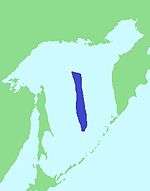Peanut Hole
Coordinates: 55°30′N 149°30′E / 55.500°N 149.500°E

The Peanut Hole is an area of open ocean at the center of the Sea of Okhotsk. From 1991 to 2014 its status was the subject of international disputes.
The Peanut Hole (named for its shape)[1] is an area about 55 kilometres (34 miles) wide and 480 kilometres (300 miles) long,[1] which is surrounded by Russia's exclusive economic zone (EEZ) extending from the shores of the Kamchatka Peninsula, Kuril Islands, Sakhalin Island, and the Russian mainland (Khabarovsk Krai and Magadan Oblast), but is not in Russia's default EEZ because it is more than 200 nautical miles from any coast.
EEZ are not areas of sovereignty, but are areas of certain sovereign rights and functional jurisdiction. Since the Peanut Hole was not in the Russian EEZ, any nation could fish there, and some began doing so in large numbers in 1991, removing perhaps as much as one million metric tons of pollock in 1992.[1] This was seen by the Russian Federation as presenting a danger to Russian fish stocks, since the fish move in and out of the Peanut Hole from the Russian EEZ.[1] (This situation is called a "straddling stock".)
| “ | [T]hirty-nine Polish supertrawlers burst into the central part of the Sea of Okhotsk... followed by nine large South Korean trawlers and almost the entire Chinese fishing fleet. Somewhat later, fishing ships from Japan, Panama, Bulgaria, and Ukraine appeared. A wild revelry began... Reluctant to observe elementary international fishing regulations, foreign fishermen set to clearing out the wealth of the northern sea. | ” | |
| — Yelena Matveyeva, On the Brink of a Military Conflict in the Sea of Okhotsk, Moscow News Weekly[2] | |||
In 1993, China, Japan, Poland, Russia and South Korea agreed to stop fishing in the Peanut Hole until the pollock stocks recover, but without an agreement on how to proceed after that,[3] while the United Nations Straddling Fish Stocks Agreement, which became effective in 2001, created a framework intended to help implement cooperative management of straddling stocks.
The Russian Federation petitioned the United Nations to declare the Peanut Hole to be part of Russia's continental shelf. In November 2013 a United Nations subcommittee accepted the Russian argument,[4] and in March 2014 the full United Nations Commission on the Limits of the Continental Shelf ruled in favor of the Russian Federation,[5]
Further reading
- Oude Elferink, Alex G. (2001). "The Sea of Okhotsk Peanut Hole De facto Extension of Coastal State Control". In Olav Schram Stokke. Governing High Seas Fisheries: The Interplay of Global and Regional Regimes. Oxford University Press. doi:10.1093/acprof:oso/9780198299493.003.0007. ISBN 9780198299493. Retrieved November 1, 2013.
References
- 1 2 3 4 Jon K. Goltz (1995). "The Sea of Okhotstk Peanut Hole: How the United Nations Draft Agreement on Straddling Stocks Might Preserve the Pollack Fishery" (PDF). Pacific Rim Law & Policy Association. Retrieved November 24, 2013.
- ↑ Moscow News Weekly, On the Brink of a Military Conflict in the Sea of Okhotsk, August 20 1993. (quoted in Goltz)
- ↑ "Peanut Hole agreement". United Nations. 1993. Retrieved November 24, 2013.
- ↑ "'Ali Baba's cave': UN declares Russian sovereignty over resource-rich Sea of Okhotsk enclave". RT (Russia Today). November 16, 2013. Retrieved November 24, 2013.
- ↑ United Nations Commission on the Limits of the Continental Shelf (March 14, 2014). "SUMMARY OF RECOMMENDATIONS OF THE COMMISSION ON THE LIMITS OF THE CONTINENTAL SHELF IN REGARD TO THE PARTIAL REVISED SUBMISSION MADE BY THE RUSSIAN FEDERATION IN RESPECT OF THE SEA OF OKHOTSK ON 28 FEBRUARY 2013" (PDF). United Nations. Retrieved May 25, 2014.